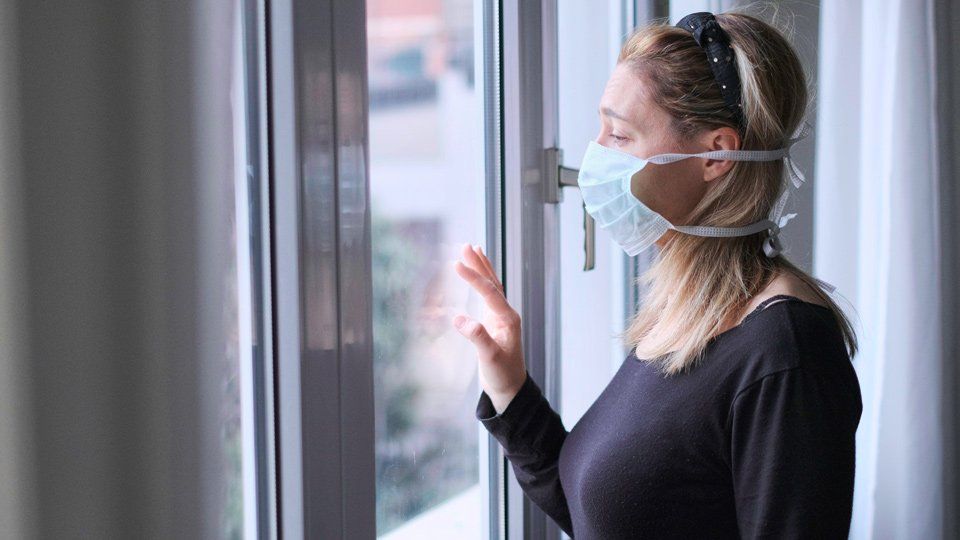Suicide Awareness and Prevention
SEPTEMBER IS NATIONAL SUICIDE PREVENTION AND AWARENESS MONTH
We use this month to raise awareness, reach out to those affected by suicide and connect individuals with suicidal ideation to appropriate treatment services.
This is a time to share resources and stories in an effort to shed light on this highly stigmatized topic. It is important to ensure that individuals, friends and families have access to the resources they need to discuss suicide prevention. The feelings of shame and stigma associated with suicide may prevent people from talking openly. However, it is essential to note that having suicidal thoughts does not mean someone is weak or flawed.
While suicide prevention is important to address year-round, Suicide Prevention Awareness Month provides a dedicated time to come together with collective passion and strength around a difficult topic. The truth of the matter is we can all benefit from honest conversations about mental health conditions and suicide. Just one conversation can change a life.
The following provides various data and information about the statistics, warning signs, risk factors, and prevention tips for suicide. It also includes various crisis resources to utilize if needed.
STATISTICS
- According to the National Alliance on Mental Illness, more than 41,000 individuals die by suicide each year, leaving behind thousands of friends and family members to navigate the tragedy of their loss.
- Suicide is the 10th leading cause of death among adults in the U.S., and the 2nd leading cause of death among people aged 10-24
- Firearms account for almost 50% of all suicides
WARNING SIGNS
- Threats or comments about killing themselves, also known as suicidal ideation, can begin with seemingly harmless thoughts like “I wish I wasn’t here” but can become more overt and dangerous
- Increased alcohol or drug use
- Aggressive behavior
- Social withdrawal from friends, family and the community
- Dramatic mood swings
- Talking, writing, or thinking about death
- Impulsive or reckless behavior
- Something to look out for when concerned that a person may be suicidal is a change in behavior or the presence of entirely new behaviors. This can be concerning if the new or changed behavior is related to a painful event, loss, or change. Most people who take their lives exhibit one or more warning signs, either through what they say or what they do
RISK FACTORS
- Mental Illness. According the National Alliance on Mental Illness, research has found that about 90% of individuals who die by suicide experience mental illness
- A family history of suicide
- Substance abuse. Drugs and alcohol can result in mental highs and lows that exacerbate suicidal thoughts
- Intoxication. More than one in three people who die from suicide are found to be currently under the influence
- Access to firearms
- A serious or chronic medical illness
- Gender. Although more women than men attempt suicide, men are four times more likely to die by suicide
- A history of trauma or abuse
- Prolonged stress
- Isolation
- Age. People under age 24 or above age 65 are at higher risk for suicide
- A recent tragedy or loss
- Agitation or sleep deprivation
- Previous suicide attempts
- Exposure to another person’s suicide, or to graphic or sensationalized accounts of suicide
PREVENTION TIPS
- It can be frightening and intimidating when a loved one reveals or shows signs of suicidal thoughts. However, not taking thoughts of suicide seriously can have a devastating outcome. If you think your friend or family member will hurt themselves or someone else, call 911 immediately
- Mental health professional are trained to help a person understand their feelings and can improve mental wellness and resiliency. They can provide effective ways to help
- Psychotherapy such as cognitive behavioral therapy and dialectical behavioral therapy, can help a person with thoughts of suicide recognize unhealthy patterns of thinking and behavior, validate troubling feelings, and learn coping skills
- According to the American Foundation for Suicide Prevention, there are many small studies of various interventions, including promising short-term therapies that include the family, have also proven to be beneficial
- Medication can be used if necessary to treat underlying depression and anxiety and can lower a person’s risk of hurting themselves. Depending on the person’s mental health diagnosis, other medications can be used to alleviate symptoms
- Be Educated. One of the best things you can do if you know or suspect that your loved one is contemplating suicide is to educate yourself. Learning about suicide, what the warning signs are, and how it can be prevented can help you understand what you need to do as a member of their support system
- Remove means such as guns, knives, or stockpiled pills
- Talk openly and honestly about suicide. Don’t be afraid to ask questions.
CRISIS RESOURCES
- If you or someone you know is in an emergency, call 911 immediately
- If you are in crisis or are experiencing difficult or suicidal thoughts, call the National Suicide Hotline at 1-800-273-TALK (8255)
- If you’re uncomfortable talking on the phone, you can also text NAMI to 741-741 to be connected to a free, trained crisis counselor on the Crisis Text Line
RESOURCES
National Alliance on Mental Illness
American Foundation for Suicide Prevention
Dr. Adam Share
Athans and Associates
Behavioral Health Care Consultants
32 Main Street, Park Ridge, IL 60068

Photo via Pexels In today’s fast-paced world, stress can often feel like an unavoidable companion. However, with the right strategies, it’s possible to cultivate a life that prioritizes mental well-being and balance. Whether it’s through career adjustments, effective time management, or embracing relaxation techniques, there are numerous ways to mitigate stress. In this article, we’ll go over several things you can do to minimize stress and feel better each day.

The Covid-19 virus is dated 2019 but came to us in a big way by February,2020 and continues to have a major impact in our lives. We have learned some things about the virus since then, but more so about how it has impacted us. The required social isolation/distancing has affected our lives to a great extent, changing our work, school, and social time a great deal. Adults have been required to work from home in order to avoid physical contact with others. This means eight to ten hours per day on the computer using videoconferencing software to be in contact with staff, clients, etc. Students, too, struggle with no contact outside the home, video conferencing all day long, sometimes with structure and direction, sometimes wondering about somewhat aimlessly on the computer if there is less guidance. Parents often complain that they don’t have the time to supervise their kids on the computer, as they are concerned about doing their job. This is especially true at a time when some jobs are expendable due to a change in the economy created by…Covid -19. Socialization is important to all us: adults, adolescents, children, toddlers, even animals! Have you noticed how your cat or dog shows you how they missed you when you were at work and returned home? Science tells us that socialization was even evident with the caveman. Research shows that being social is an important part of our mental health. This is because talking, sharing thoughts and feelings allows us to “vent,” but also reminds us that we are not alone in solving those problems. Additionally, empathy given, and empathy received goes a long way. “I know how you feel” can be uplifting. Participating, observing one’s smile, laughing together reminds us that we are not alone. Socialization adds to our happiness and well-being. Developmentally, children learn to trust at a young age. Sharing thoughts, feelings, toys, etc. means reaching out to others. They may get hurt emotionally, but then they learn more about relationships and eventually take more risks. Children learn and experience their family first-hand. Getting close, trusting, taking care of, etc. is all part of the process. So, the family is important socially, but our current-day society goes way beyond that. In recent times we spend more time out of the home than in the home (short of sleep time). Social distancing and social isolation have immense personal consequences leading to symptoms of anxiety, stress, fear, sadness, depression and even helplessness and possible suicide. When experiencing these symptoms, we often eat too much and irresponsibly, become lax in physical activity, at times, over-indulge in alcohol, drugs, etc., resulting in even more pronounced symptoms over time. The damage to our bodies and minds is incalculable. While you may have heard of some of these recommendations, do not overlook them. It is not so much all or nothing, rather work toward healthy lifestyles. The support of your partner and family working together will make it much more effective and pleasing to all.

It’s natural that we become anxious and worried as we are clustered in our homes with the current “stay at home” government order. Worry and rumination are not uncommon, naturally wondering: Will we be ok? What about relatives, friends, neighbors who we can’t physically see so easily? There is a real sense of loss of control. It is not uncommon for our sleep, appetite, and mood to be affected. There may be increased use of alcohol, tobacco or other drugs. Sometimes existing health problems are exacerbated. We may feel pre-occupied, “spacey,” etc.
Most parents are familiar with the struggle of setting limits on the amount of screen time their children have each day. With so many gadgets – computers, TVs, smart phones, tablets, video game systems – children have a cornucopia of devices to choose from. Technology does have its merits and benefits. Smartboards are in many classrooms and a large amount of homework requires the use of a computer. Although unlimited screen time may keep your children quiet, too much screen time is not good for kids. Several research studies have shown that too much screen time can have a detrimental effect on a child’s health – both mental and physical. Too much screen time can make it difficult for children to fall asleep at night. An overabundance of screen time can increase a child’s risk of attention problems, anxiety, and depression. Time spent on a screen is time not spent being active, raising a child’s risk of gaining too much weight. TV commercials and other screen ads can lead to unhealthy food choices. Food ads that are aimed at kids are often high in sugar, salt, or fats. Additionally, children tend to eat more when they are watching TV. So how much screen time is too much? The American Academy of Pediatrics has issued guidelines to help parents determine appropriate limits. Children under the age of two should have no screen time. For children over the age of two, limit screen time to two hours per day. Despite what ads may say, videos aimed towards young children do not improve their development. However, most parents know that setting limits on the amount of television your child watches or how much time your teen spends playing video games is easier said than done! Here are some tips to help you limit screen time to a healthy, reasonable amount.
If the idea of a family vacation evokes mental images of a frazzled Clark Griswold, you’re not alone. Our daily routines feel safe and predictable and it’s not always easy to step away, especially when kids are involved. Nevertheless, these adventures provide valuable opportunities for families to practice compromise, adaptation, problem-solving, frustration tolerance, and of course, communication. What’s more, the benefits often outlast the actual experience. A successful family vacation has the potential to enrich a family’s identity and provide “happiness anchors” – a set of soothing memories to mentally recall when we are stressed or anxious. Keep in mind, a “successful” family vacation is not guaranteed and like most adventures, a little planning goes a long way. What follows are helpful tips to make the most of your time away:
Holiday times remind us of special significance and meaning. For many this can be a joyful time, for others, this can be a time of great stress. Read more in our blog...
Parents go back to school, like their children. Parents have to reorganize the house, buy school supplies, buy clothes and uniforms for the kids, buy sport equipment, reorganize schedules, make doctor’s appointments, etc. Parents have to arrange carpools, take kids to sports practices, games, tutors, homework, bedtimes. Parents have their own jobs, the house, as well as the children to manage. This can be overwhelming and stressful. And we tend to take care of everyone else first. We encourage you to take care of yourselves . Find work-life balance. Eat healthy foods. Pet the dog. Get enough sleep, Walk for a few minutes outside. Plan for child care. Read. Listen to music. Pray. Practice deep-breathing. Hug your spouse. The healthier and happier you are…the better your family. Dr. Lynda Behrendt Licensed Clinical Psychologist Athans and Associates 32 Main Street, Park Ridge, IL 60068 www.athansandassociates.net (847) 823-4444
It’s summer and…I’M BORED!!! This is an all too familiar complaint for many parents. Summer is supposed to be laid-back, less stressful, and full of positive feelings, right? However, the transition from a structured schedule to the unstructured days of summer often can be challenging. This is especially true for children with anxiety, ADHD and autism spectrum disorders. Summer also tends to have a focus on being more social and this can lead to feelings of isolation for some children who struggle with depression or social challenges. Here are some tips to be mindful of during the summer months:
Developing a plan on responding to negative behaviors in children. This post discusses the tools used to do so.
Humans have communicated via storytelling for thousands of years. Prior to the codification of language, non-verbal acts such as pantomime were used to inspire, educate, and entertain. The advent of language allowed for a more refined method of addressing some of life’s most pressing questions. Within the process of storytelling, both the teller and the listener are thought to benefit. The former is given an opportunity to share, while the latter may find comfort in the connection. Case in point: my first-ever concert was legendary blues guitarist B.B. King at the long-gone Poplar Creek Music Theater. As was typical, he opened the show with his classic tale of woe, The Thrill Is Gone. As he bellowed such lines as “the thrill is gone away from me / although I’ll still live on / so lonely I will be,” the crowd erupted with cheers of approval as the storyteller put words and melody to a universally relatable feeling. Recent findings from UCLA’s Social Cognitive Neuroscience Laboratory appear to support this idea. This research team found that when participants were shown photos of angry faces, the region of the brain that prepares us to defend ourselves exhibited increased activity. When participants were then asked to verbally assign descriptive words such as “angry” or “mad” to the images, the same area of the brain appeared to cool. In the words of UCLA psychologist Matthew Lieberman, “This is ancient wisdom, but now we can verify it with brain mapping.” It appears that both “The King Of The Blues” and these Bruin Brainiac’s support the idea that emotionally-rich expressions have therapeutic benefits. So how can we apply this to our lives? It’s not as easy as it would seem. Within families, effective communication allows us to better understand and connect with those around us. Unfortunately, the chaotic crisscross of daily life often leaves little time for meaningful connections. A few tips:













